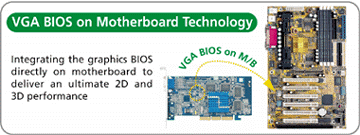Gigabyte GA-MG400 Matrox G400 AGP
by Anand Lal Shimpi on February 3, 2000 4:02 AM EST- Posted in
- GPUs
Why would Matrox, a graphics card manufacturer, want to team up with Gigabyte to produce OEM versions of their G400 products? First, you must understand Matrox’s motives behind this move.
Matrox wanted to keep their profits high, but at the same time needed help gaining market acceptance. Normally when you want to gain market acceptance you go to an OEM computer manufacturer and get them to use your graphics cards in all of their systems, or at least offer them as an option. Matrox had done that, but what Gigabyte offered was another unique approach to gaining market acceptance
If you recall, towards the end of 1998 we began to see motherboards featuring integrated G200 chips. This was a smart move on Matrox’s behalf since it did not interfere with their G200 card sales yet it increased the acceptance of the G200 into the market since there were now motherboards shipping to OEMs with on-board G200 chips.
Since the G400 is too expensive of a product to integrate onto a motherboard as a low-cost solution, Gigabyte decided to place another part of the G400 card onto the motherboard, and in doing so took off around 10% of the overall cost of the card. What part is this? The VGA BIOS.
VGA BIOS on Motherboard Most
motherboards currently ship with 1 – 4Mbit BIOS ROMs on-board. Gigabyte’s theory
was that if you used some of the storage area on the motherboard’s ROM to store
what would normally be placed on the video card’s BIOS, you could cut costs
by not having to include a BIOS on the graphics card itself. This would also
mean that in order to use a graphics card without a BIOS, you’d need to be using
a motherboard that had the VGA BIOS on the on-board ROM, and if Gigabyte were
the only motherboard manufacturer that supported this, then you would have to
buy a Gigabyte motherboard.
Most
motherboards currently ship with 1 – 4Mbit BIOS ROMs on-board. Gigabyte’s theory
was that if you used some of the storage area on the motherboard’s ROM to store
what would normally be placed on the video card’s BIOS, you could cut costs
by not having to include a BIOS on the graphics card itself. This would also
mean that in order to use a graphics card without a BIOS, you’d need to be using
a motherboard that had the VGA BIOS on the on-board ROM, and if Gigabyte were
the only motherboard manufacturer that supported this, then you would have to
buy a Gigabyte motherboard.
From Matrox’s standpoint the deal was equally as beneficial. Matrox only had to produce the G400 chips and ship them to Gigabyte. Gigabyte would then produce cards based on the G400 but would include the VGA BIOS in the BIOS of their motherboards, thus adding another requirement for the video card, you’d have to own a Gigabyte motherboard that supported this feature. What this would accomplish is a greater market acceptance of the G400 chip, without truly interfering with Matrox’s G400 card sales.
And the technology that we’re talking about here was ‘creatively’ dubbed by Gigabyte as VGA BIOS on Motherboard. The first G400 based card Gigabyte has released that takes advantage of the VGA BIOS on Motherboard technology is the 16/32MB Gigabyte GA-MG400.










0 Comments
View All Comments